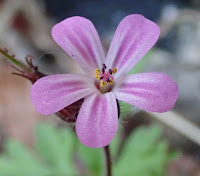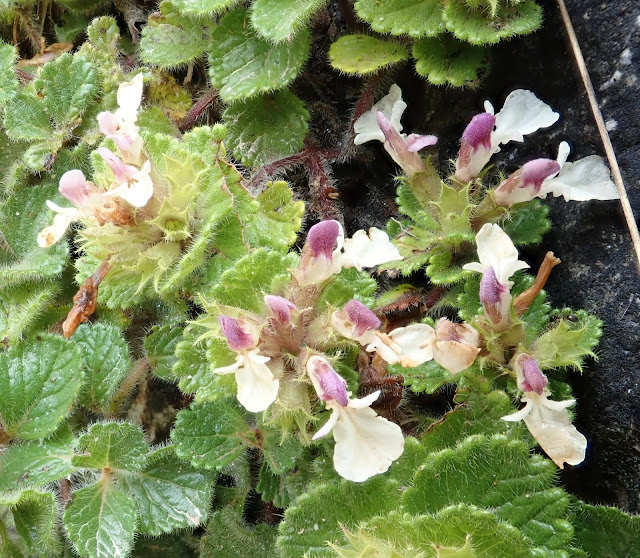The Picos de Europa , in Northern Spain was visited from 30th June to 6th July 2018. The main attractions are a wide range of Alpine plants and the spectacular scenery.
 |
| View north from Puerto De San Glorio |
This was my first visit and under researched. Despite this a lot of interesting flowers were seen and photographed. We stayed in Potes which was ideal being lively and well placed to visit the main attraction of the Fuente De cable car which takes you up 800m directly to the alpine plant zone. Also visited were the Garganta del Cares ( Cares Gorge) which can be walked from Puente Poncebos to the tiny and remote village of Cain and finally the Puerto De San Glorio, a high pass south west of Potes. Ten photos follow as examples of what was seen in Cares Gorge and in the Alpine Zone at the top of the cable car.
Day 1 Garganta del Cares.
Little Robin ( Geranium purpureum ) which is quite a rare plant in the UK and has smaller flowers than the common Herb Robert ( Geranium robertianum). Rather nice to see plants that occur rarely at home.
 |
| Pink Petals and yellow anthers |
2) Pyrenean Germander ( Teucrium pyrenaicum). Mint family.
Quite common from alpine zone to lower levels.
Quite common from alpine zone to lower levels.
3) Alpine Toadflax ( Linaria alpina ssp. filicaulis ) A sub species found in the Picos mountains.
3a) Chaenorhinum Chaenorhionum origanifolium ( Linaria origanifolia )
Another small pink Toadflax but the spur is very short and has green oval leaves.
 |
| Bright pink toadflax growing beside the main track with grey-green leaves. |
3a) Chaenorhinum Chaenorhionum origanifolium ( Linaria origanifolia )
Another small pink Toadflax but the spur is very short and has green oval leaves.
4) Common Columbine ( Aquilgia vulgaris )?
ID of this one is not so certain as there are several Columbine which occur in the Picos. The Common Columbine usually has hairy stems whereas the Pyrenean Columbine (Aquilegia pyrenaia) is more or less hairless. A third possibility A. argonensis has densely hairy stems and flowers with short spurs. (Ref Alpine Flowers of Britain and Europe by C. Grey-Wilson.)
A closer look at the stems show these plants to be densely hairy but the spurs do not look short hence the probability that this plant is Common Columbine.
ID of this one is not so certain as there are several Columbine which occur in the Picos. The Common Columbine usually has hairy stems whereas the Pyrenean Columbine (Aquilegia pyrenaia) is more or less hairless. A third possibility A. argonensis has densely hairy stems and flowers with short spurs. (Ref Alpine Flowers of Britain and Europe by C. Grey-Wilson.)
A closer look at the stems show these plants to be densely hairy but the spurs do not look short hence the probability that this plant is Common Columbine.
Day Two , Fuente De to the Refugo de Aliva ( Alpine Zone)
5 Rock Jasmine (Androsace villosa)
The strange feature of this plant is that the centre of the flower starts yellow and turns pink then red as it matures.
6) Thyme-leaved Globe-daisy also called Creeping Globularia ( Globularia repens)
7) Pyrenean Trumpet Gentian ( Gentiana occidentalis)
My first 'Trumpet Gentian', not the most subtle plant but distinguished from the similar Trumpet Gentian ( G. acaulis) by the very pointed petals however there are several similar species of Trumpet Gentian and they do not look easy to tell apart. G. occidentalis would appear from botanical trip reports to be the only one present in the Picos mountains.
8) Fairy Foxglove ( Erinus alpinus )
This plant gave me considerable problems in my attempts to work out what is was. The upper petal is split whereas the side and lower petals are notched and this is a very odd feature. What I had not appreciated is that the split upper petal is considered to be two petals and this is a five petal flower.
When you limit your search to exclude five petal flowers and concentrate on four petal flowers you do not get very far. Fortunately Jenny Field came to the rescue and suggested Fairy Foxglove, an alpine plant from the mountains of Spain and south and central Europe and also found as an escape in the UK. No sub-species are recognised.
9) Spring Gentian ( Gentiana verna )
This plant that I had seen before, on a trip to the Burren, Ireland in late May. Unlike the Burren where Spring Gentian is the only Gentian, and probably its most famous plant, mainland Europe has quite a few Blue Gentians and a bit more care was required to ID the plants in the Picos. The Calyx was narrowly winged and G. verna seemed the best fit.
10) Pygmy Hawksbeard ( Crepis pygmaea )
Final plant of the Alpine Zone was a yellow composite growing in the rocks beside the main track.
Grey hairy leaves and red tipped petals made this a very distinctive plant.
The Alpine Flowers of Britain and Europe by Christopher Grey-Wilson and Marjorie Blamey proved very useful in identification of these plants.
Peter Leonard 25th Aug 2018
5 Rock Jasmine (Androsace villosa)
The strange feature of this plant is that the centre of the flower starts yellow and turns pink then red as it matures.
6) Thyme-leaved Globe-daisy also called Creeping Globularia ( Globularia repens)
7) Pyrenean Trumpet Gentian ( Gentiana occidentalis)
My first 'Trumpet Gentian', not the most subtle plant but distinguished from the similar Trumpet Gentian ( G. acaulis) by the very pointed petals however there are several similar species of Trumpet Gentian and they do not look easy to tell apart. G. occidentalis would appear from botanical trip reports to be the only one present in the Picos mountains.
8) Fairy Foxglove ( Erinus alpinus )
This plant gave me considerable problems in my attempts to work out what is was. The upper petal is split whereas the side and lower petals are notched and this is a very odd feature. What I had not appreciated is that the split upper petal is considered to be two petals and this is a five petal flower.
When you limit your search to exclude five petal flowers and concentrate on four petal flowers you do not get very far. Fortunately Jenny Field came to the rescue and suggested Fairy Foxglove, an alpine plant from the mountains of Spain and south and central Europe and also found as an escape in the UK. No sub-species are recognised.
9) Spring Gentian ( Gentiana verna )
This plant that I had seen before, on a trip to the Burren, Ireland in late May. Unlike the Burren where Spring Gentian is the only Gentian, and probably its most famous plant, mainland Europe has quite a few Blue Gentians and a bit more care was required to ID the plants in the Picos. The Calyx was narrowly winged and G. verna seemed the best fit.
10) Pygmy Hawksbeard ( Crepis pygmaea )
Final plant of the Alpine Zone was a yellow composite growing in the rocks beside the main track.
Grey hairy leaves and red tipped petals made this a very distinctive plant.
The Alpine Flowers of Britain and Europe by Christopher Grey-Wilson and Marjorie Blamey proved very useful in identification of these plants.
Peter Leonard 25th Aug 2018
















No comments:
Post a Comment